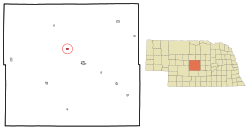Merna, Nebraska facts for kids
Quick facts for kids
Merna, Nebraska
|
|
|---|---|
|
Village
|
|

Downtown Merna: north side of Center Avenue
|
|

Location of Merna, Nebraska
|
|
| Country | United States |
| State | Nebraska |
| County | Custer |
| Township | Kilfoil |
| Area | |
| • Total | 0.54 sq mi (1.39 km2) |
| • Land | 0.54 sq mi (1.39 km2) |
| • Water | 0.00 sq mi (0.00 km2) |
| Elevation | 2,661 ft (811 m) |
| Population
(2020)
|
|
| • Total | 343 |
| • Density | 639.93/sq mi (247.26/km2) |
| Time zone | UTC-6 (Central (CST)) |
| • Summer (DST) | UTC-5 (CDT) |
| ZIP code |
68856
|
| Area code(s) | 308 |
| FIPS code | 31-31780 |
| GNIS feature ID | 2399317 |
Merna is a village in Custer County, Nebraska, United States. The population was 363 at the 2010 census.
Contents
History
Merna was founded in the 1880s about the time the railroad was extended to that point. It was named Merna in honor of the young daughter of the first postmaster.
Geography
According to the United States Census Bureau, the village has a total area of 0.54 square miles (1.40 km2), all land.
Recently, Merna was at the center of a geological controversy regarding a depression in the land several miles west of town in the Loess Hills. Originally called the Bartak Depression after the owners of the land, it was redubbed the Merna Crater by University of Kansas geology professor Wakefield Dort, Jr. Further research showed the crater to be more likely formed by wind and water erosion, but memories of the flurry of importance in the small town remain.
Demographics
| Historical population | |||
|---|---|---|---|
| Census | Pop. | %± | |
| 1900 | 141 | — | |
| 1910 | 459 | 225.5% | |
| 1920 | 553 | 20.5% | |
| 1930 | 439 | −20.6% | |
| 1940 | 414 | −5.7% | |
| 1950 | 385 | −7.0% | |
| 1960 | 349 | −9.4% | |
| 1970 | 322 | −7.7% | |
| 1980 | 389 | 20.8% | |
| 1990 | 377 | −3.1% | |
| 2000 | 391 | 3.7% | |
| 2010 | 363 | −7.2% | |
| 2020 | 343 | −5.5% | |
| U.S. Decennial Census | |||
2010 census
As of the census of 2010, there were 363 people, 151 households, and 110 families living in the village. The population density was 672.2 inhabitants per square mile (259.5/km2). There were 174 housing units at an average density of 322.2 per square mile (124.4/km2). The racial makeup of the village was 98.6% White, 0.3% from other races, and 1.1% from two or more races. Hispanic or Latino of any race were 1.4% of the population.
There were 151 households, of which 32.5% had children under the age of 18 living with them, 58.9% were married couples living together, 9.3% had a female householder with no husband present, 4.6% had a male householder with no wife present, and 27.2% were non-families. 26.5% of all households were made up of individuals, and 11.3% had someone living alone who was 65 years of age or older. The average household size was 2.40 and the average family size was 2.87.
The median age in the village was 40.2 years. 27.5% of residents were under the age of 18; 6.4% were between the ages of 18 and 24; 22.6% were from 25 to 44; 30.1% were from 45 to 64; and 13.5% were 65 years of age or older. The gender makeup of the village was 48.5% male and 51.5% female.
See also
 In Spanish: Merna (Nebraska) para niños
In Spanish: Merna (Nebraska) para niños



